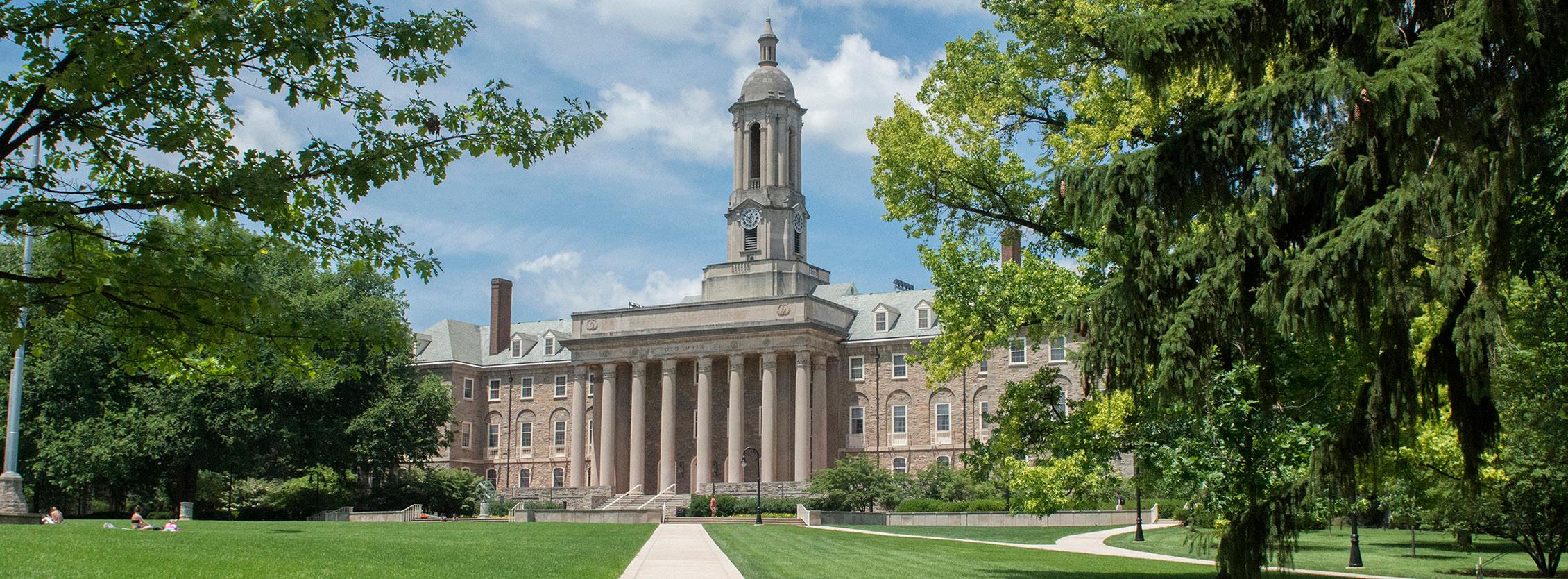PENN STATE UNIVERSITY
THE MISSION
Penn State’s historic mission of teaching, research, and public service — launched under the most modest of circumstances more than 150 years ago — now reaches into virtually all parts of Pennsylvania. Consider, for example, that the University now has 24 campuses across the Commonwealth, putting a Penn State education within practical reach of nearly every Pennsylvanian. In fact, more than 70 percent of Penn State’s undergraduates are Pennsylvania residents. Penn State is Pennsylvania’s largest nongovernmental employer and has employees and expenditures in every one of its 67 counties. The University generates a total economic impact across the Commonwealth that surpasses $17 billion annually. Part of that impact is derived from Penn State’s research program, which brought more than $534 million in federal funds to Pennsylvania last year, and an additional $91 million from private industry. In addition, as part of its Invent Penn State initiative, the University has funded 21 innovation hubs, designed to bolster entrepreneurship and economic development in communities surrounding its campuses across Pennsylvania. Penn State’s outreach and online programs — ranging from 4H to Cooperative Extension, from summer camps to public broadcasting — provide educational and service programs to more than a million Pennsylvania households annually.
THE BEGINNING
The University’s presence throughout Pennsylvania today contrasts sharply with its humble beginnings. Chartered as a college of scientific agriculture, the institution was located in rural Centre County after James Irvin, a partner in the Centre Furnace iron works (remains of which can be seen today along East College Avenue), offered to donate 200 acres of farmland for a campus. Founding President Evan Pugh wanted the fledgling institution to embody a new approach to higher education that blended classical studies with subjects that had practical value. He joined similar visionaries in other states in convincing Congress to pass the Morrill Land-Grant Act in 1862. The act gave individual states tracts of federal land to sell; the proceeds supported colleges that agreed to include engineering, science and the liberal arts as well as agriculture in their course of studies. In 1863, the Pennsylvania legislature designated Penn State the Commonwealth’s sole land-grant institution. The lawmakers in effect bestowed on the privately incorporated college a public character. In return for state support, the institution assumed obligations of teaching, research and service that are normally associated with publicly owned land-grant universities in other states. By the 1890s Penn State was making its mark. It ranked among the nation’s 10 largest undergraduate engineering schools, a distinction it still holds. It established one of the nation’s first collegiate agricultural experiment stations, and Professor Whitman Jordan’s pioneering research on using fertilizers for soil enrichment had global impact on crop yields.
62
PENN STATE 2019-20 • MEN’S GOLF
Penn State in 1871 became one of the first land-grant schools in the Northeast to admit women, graduated its first international student in 1890, and its first African-American student in 1905.
THE 20TH CENTURY
In the early 1900s, President Edwin E. Sparks supported a number of efforts to “carry the college to the people,” as he liked to say. Technical institutes were established in various locations statewide for engineering education, beginning with an evening school in Allentown in 1910. In 1912, Penn State helped create a system of county agents in agriculture and home economics. Today, the Penn State World Campus, with its “anywhere, anytime” learning through the Internet, builds on that outreach tradition. But undergraduate education remained foremost. Enrollment surpassed 5,000 students by 1936, including those attending several undergraduate centers that were created for students who, in the depths of the Great Depression, could not afford to leave their hometowns to get a college education. The centers offered the first year of baccalaureate studies and were the predecessors of today’s statewide system of campuses. Thanks to this innovative approach to higher education, Penn State in the 1930s became Pennsylvania’s largest single source of baccalaureate degrees, a distinction it holds to this day.
POST WORLD WAR II
Following World War II, Penn State underwent unprecedented expansion, first to meet the needs of returning military veterans and later to accommodate the Baby Boom generation. Total enrollment at all Penn State campuses climbed to 40,000 by 1970. The University also emerged on the national scene as a research powerhouse in fields as diverse as dairy science, acoustics, psychology and diesel engineering. The expansion of research went hand in hand with a steady increase in the number of graduate students. The University awarded its first graduate degree — a master’s degree in scientific agriculture — in 1862, and the Graduate School was established in 1922. But overall graduate enrollment remained modest until the 1950s, then swelled steadily. The Graduate School has awarded to date approximately 130,000 master’s, doctoral and other advanced degrees.
TODAY
The University Park campus is Penn State’s administrative and research hub. In addition, there are 19 primarily undergraduate campuses; Penn State Health Milton S. Hershey Medical Center and the College of Medicine; the Pennsylvania College of Technology; Penn State Law: Dickinson Law; the Penn State Great Valley School of Graduate Professional Studies; and the Penn State World Campus. To date, Penn State has awarded more than 840,000 degrees, hallmarks of an educational experience second to none in quality. In addition, Penn State alumni — including 348,000 in Pennsylvania alone — have job- and social-networking opportunities that no other college or university in the Commonwealth can surpass.






